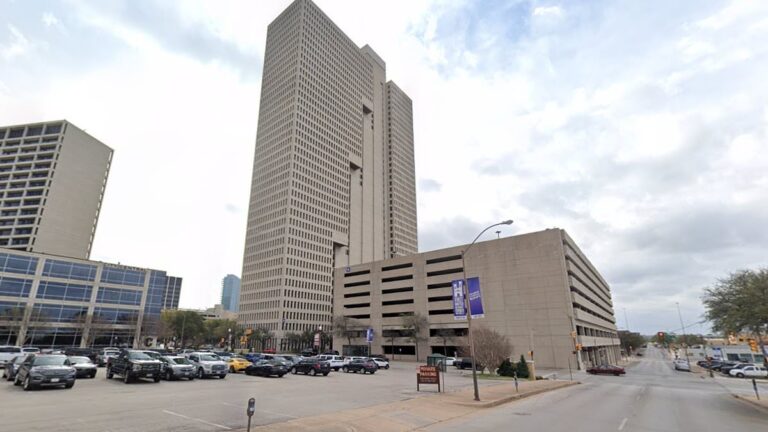- Barnett Plaza was purchased at a foreclosure auction for $12.3 million.
- 567-foot-tall blocky complex in Fort Worth, Texas
- This 40-story building was sold three years ago for more than $137.5 million
The tallest building in Fort Worth, Texas has been sold for a steep discount.
Barnett Plaza was purchased at a foreclosure auction for $12.3 million, just three years after it sold for more than $137.5 million.
The 40-story building was purchased by Pinnacle Bank of Texas during an auction at the Tarrant County Courthouse on Tuesday.
Pinnacle was used by Barnett Cherry Street LLC, an affiliate of the building's previous owner, New York-based Opal Holdings LLC, to purchase the tower in 2021, according to public records. He claimed he failed to pay a $13 million loan.
This is the latest in a ticking time bomb problem for commercial real estate in this country, as office buildings across the country remain vacant or sold at significantly lower prices.
The massive building was built in 1983 and is also considered the largest commercial office and retail space at over 1 million square feet, according to its website.
The block-like building at 801 Cherry Street is located near a public city park and stands 567 feet tall.
The Dallas Business Journal reported that the complex was recently appraised by the Tarrant Appraisal District for $104.5 million.
Tenants in the building include General Motor Financial, Kimley Horn & Associates, and Huckabee & Freeze & Nichols.
Contractors filed 10 mechanic's liens totaling more than $1.6 million against Opal Holdings LLC for unpaid site renovations, the Dallas Business Journal reported.
One of the liens, totaling about $1 million, was filed by Tyrant Construction Services for renovation work on a bathroom and two suites on the 19th floor, according to documents.
On April 2, Opal sued Pinnacle, claiming the lender had forced the building into default.
Pinnacle Bank of Texas is run by charter president Ronnie Korb, who has served on the bank's board since 1999, according to its website.
The bank itself is family-owned and operated with 29 locations in the Lone Star State and 167 locations in eight other states.
The building vacancy rate was 22% last quarter, compared to just 11.5% in Fort Worth's downtown area, according to The Real Deal.
Commercial and office real estate is surviving on the brink as soaring interest rates and the slow return of workers to offices begin to take their toll and foreclosures rise across the country.
Along with Texas, commercial foreclosures are also on the rise in California, New York, Florida, and New Jersey.
There were approximately 625 commercial real estate foreclosures in March, a 6% increase compared to February and a 117% increase compared to the same period in 2023, according to the latest statistics from real estate data provider ATTOM.
In California, 187 properties faced foreclosure in March, the highest number ever for the state.
Real estate investment management firm Shorenstein recently put the 62-story Aon Center in Los Angeles on the market for $153.5 million, down from $269 million a decade ago.
In January, Blackstone, the world's largest private equity fund, put the landmark New York City building on the market for a quarter of what it originally paid for it.
Blackstone bought the 26-story tower at 1740 Broadway in 2014 for about $600 million and has since offered it to anyone willing to pay the $150 million remaining on the mortgage. are doing.
Small and regional banks are the largest source of credit in the commercial real estate market, holding approximately 80% of the sector's outstanding debt.
“I think this is an existential moment,” said Scott Rechler, director of RXR Real Estate.
“In this post-corona world, where interest rates are rising and the nature of how people work and live is changing, we will not go back to normal, we will be disrupted.”
An astonishing 19.6 percent of office space in the United States is vacant, the highest vacancy in 40 years.
This record slightly surpassed the previous record of 19.3% set in 1986 and 1991. The lowest vacancy rate was in 1976, at about 6%.
A surge in vacant office buildings in the 1980s and 1990s was followed by a surge in overbuilding, particularly in southern cities such as San Antonio, Dallas, and Austin, Texas, as the nation continued to buy up cheap land.
In 1991, cities such as Fort Lauderdale, Palm Beach, and New Orleans in Florida were the three major cities facing job vacancies in the United States.
At the time, banks were known to finance proposed spaces even if there were no tenants to occupy the building. Developer Bruce Eichner said the nearly 1 million square foot Manhattan office building he built in the 1980s was “100 percent empty.”
In October, Microsoft joined the Bay Area's “tech-xodus,” touting up to 49,000 square feet of office space to sublease as the city continues to slip into a “loop of doom.”
Meta and LinkedIn are also subletting office space in the city as rising crime drives storefronts out of downtown areas and vacancy rates hit a record 34% in September.

